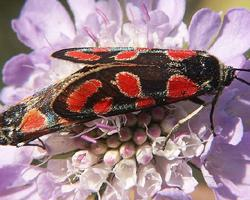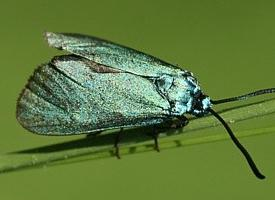
Váhy a míry
| Délka | od 25 do 32 mm |
|---|
Stav ohrožení
| Neohrožen |
Popis zvířete
The Crepuscular Burnet, scientifically known as Zygaena carniolica, is a captivating species of moth that belongs to the Zygaenidae family. This family is known for its brightly colored and day-flying moths, which often feature metallic hues, making them some of the most visually appealing insects. Zygaena carniolica, in particular, boasts a range of distinctive features and behaviors that set it apart within the rich tapestry of Lepidoptera.Adult Crepuscular Burnets are primarily recognized by their striking wing pattern and coloration. The forewings exhibit a deep, velvety black background that beautifully contrasts with spots of a vivid red or sometimes yellow color, depending on the subspecies or regional genetic variations. These spots are not merely decorative; they serve as a warning to predators about the moth's unpalatability, a defense mechanism known as aposematism. The hindwings are usually a more subdued black or dark gray, with a similar coloration of spots. When at rest, their wings are held tightly together, displaying the forewings' pattern and camouflaging the moth against predators.
One of the most fascinating aspects of the Crepuscular Burnet is its crepuscular activity pattern. Unlike many other diurnal members of its family, Zygaena carniolica is most active during the twilight hours of dawn and dusk. This behavior helps the moth avoid the most intense daytime predators and heat, which is particularly advantageous during the hot summer months in its habitats.
The Crepuscular Burnet has a preference for warm, dry environments, often found in meadows, grasslands, and sometimes light woodlands across Central and Eastern Europe. Its larvae feed on a variety of plants, particularly favoring species within the Fabaceae family, such as clovers (Trifolium) and vetches (Vicia). This diet plays a crucial role in the development and survival of the larvae, as the plants provide essential nutrients for growth and development.
The life cycle of Zygaena carniolica is another point of interest. After mating, females lay their eggs on the underside of host plant leaves. Upon hatching, the larvae begin feeding on their host plant, going through several instars before pupating. The pupal stage occurs in a cocoon attached to vegetation near the ground, where it remains through the winter, emerging as an adult moth in late spring or early summer. This life cycle, closely tied to the availability of host plants and seasonal changes, underscores the moth's adaptation to its environment.
Conservation status of the Crepuscular Burnet varies by region, with habitat loss due to agricultural expansion and urban development posing significant threats to some populations. Efforts to preserve its natural habitats are crucial for the maintenance of its populations and the ecological balance of the areas it inhabits.
In summary, the Crepuscular Burnet, Zygaena carniolica, is a remarkable moth species with distinctive visual characteristics, an interesting life cycle, and specific habitat preferences. Its presence enriches the biodiversity of its native regions and serves as a beautiful example of the intricate relationships between organisms and their environments.
Podobná zvířata
Nové fotografie zvířat
Top 10 zvířat
- Dolphin gull (Leucophaeus scoresbii)
- Diana monkey (Cercopithecus diana)
- Moustached guenon (Cercopithecus cephus)
- Greek tortoise (Testudo graeca)
- Stone loach (Barbatula barbatula)
- Galápagos tortoise (Geochelone nigra complex)
- Japanese macaque (Macaca fuscata)
- Russian tortoise (Testudo horsfieldii)
- Common flying dragon (Draco volans)
- Galápagos penguin (Spheniscus mendiculus)
